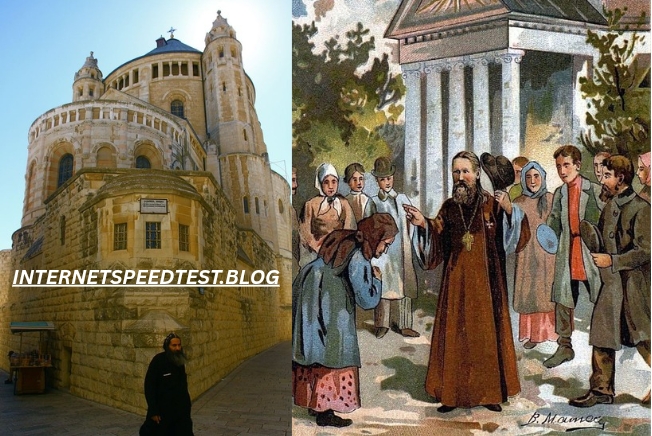Introduction
The Crypt of Saint Jonah of Kiev is one of the most fascinating yet lesser-known religious sites in Eastern Europe. Situated within the spiritual heart of Ukraine, this crypt is not only a sacred burial chamber but also a site of pilgrimage, legends, and centuries-old traditions. While Kiev (Kyiv) is widely recognized for its golden-domed monasteries and cathedrals, the crypt of Saint Jonah has retained a unique aura, combining religious devotion with mysterious tales.
This article explores the history, significance, architecture, miracles, and cultural symbolism of the Crypt of Saint Jonah of Kiev. From its foundation to its place in modern-day Ukraine, the story of this crypt reflects the deep intertwining of faith and national identity.
Who Was Saint Jonah of Kiev?
Saint Jonah of Kiev, also known as Jonah the Wonderworker, was a monk and spiritual leader whose life is associated with holiness, service, and miracles. He lived during the 15th century and rose to prominence in Kiev’s monastic community.
Early Life and Spiritual Calling
- Saint Jonah was drawn to monastic life from an early age.
- He became a monk at the Kiev Caves Monastery, a center of Orthodox spirituality.
- Known for his humility and wisdom, Jonah attracted followers who regarded him as a spiritual father.
His Role in the Church
Jonah eventually became Metropolitan of Kiev and All Rus, guiding the faithful during turbulent times. His leadership preserved Orthodox traditions despite political divisions and external threats.
Death and Sainthood
After his death, he was buried with great reverence. Over the centuries, stories of healing and answered prayers at his resting place contributed to his canonization. Thus, the Crypt of Saint Jonah became a center of pilgrimage.
The Location: Kiev as a Spiritual Capital
Kiev is often referred to as the “Mother of Rus’ Cities”, a title that reflects its pivotal role in the spread of Christianity in Eastern Europe. With landmarks such as:
- Kiev Pechersk Lavra (Monastery of the Caves)
- Saint Sophia’s Cathedral
- Church of the Tithes
The city has always been a magnet for pilgrims. Within this setting, the crypt of Saint Jonah developed as a more intimate and mystical spiritual site.
The Crypt of Saint Jonah: Origins and Construction
Architectural Foundations
The crypt is traditionally believed to have been constructed in the underground passages of a monastery associated with Saint Jonah. These underground complexes were carved from soft rock and clay, forming narrow corridors and chambers.
Symbolism of Underground Burial
In Orthodox tradition, burial in crypts or caves symbolizes humility and closeness to the earth. For Saint Jonah, this burial site became more than a resting place—it became a sacred sanctuary.
Preservation of Relics
Saint Jonah’s relics were carefully preserved within the crypt. According to believers, his body showed signs of incorruptibility, which further fueled devotion and reverence.
Legends and Miracles of the Crypt
Miraculous Healings
Countless pilgrims have reported healings after praying at the crypt. Illnesses, blindness, and even mental afflictions were believed to be cured through Saint Jonah’s intercession.
The Candle That Never Burned Out
One popular legend tells of a candle placed at his tomb that burned continuously without melting, symbolizing eternal divine presence.
Protection During Invasions
During times of war and foreign invasions, locals claimed that the crypt of Saint Jonah was miraculously spared from destruction.
Pilgrimage and Rituals
For centuries, the crypt has been a destination for Orthodox pilgrims.
Pilgrimage Practices
- Pilgrims walk barefoot into the crypt to show humility.
- Offerings of candles, bread, and oil are common.
- Special liturgies and prayers for healing are held at the site.
Spiritual Atmosphere
The crypt is dimly lit, with an air thick with incense. Chanting echoes against stone walls, creating an otherworldly experience for visitors. Many describe a sense of peace and divine presence that is difficult to put into words.
and Religious Symbolism
The crypt of Saint Jonah is not just a burial site but a symbol of resilience.
Faith in Times of Hardship
Throughout Ukraine’s history, from Mongol invasions to Soviet repression, sites like the crypt kept faith alive among believers.
A Bridge Between Heaven and Earth
In Orthodox theology, saints are viewed as intercessors. Saint Jonah’s crypt is thus seen as a gateway of prayer connecting the faithful with divine grace.
Soviet Era Suppression
During the Soviet period, religious institutions across Ukraine faced closures and persecution.
- Many crypts and monasteries were destroyed or turned into museums.
- Pilgrimage was forbidden, but locals secretly maintained their devotion.
- Stories circulated of secret midnight prayers in the crypt of Saint Jonah.
This underground resistance helped preserve religious identity even under strict atheistic policies.
Rediscovery and Modern Relevance
After the fall of the Soviet Union, Ukraine experienced a revival of Orthodoxy. The crypt of Saint Jonah regained its rightful place as a holy site.
Modern-Day Pilgrimages
Thousands of visitors now come each year, not only from Ukraine but from across Eastern Europe.
Academic and Historical Interest
Scholars have also shown interest in the crypt, studying its architecture, relics, and role in preserving Ukrainian cultural identity.
Symbol of National Identity
For modern Ukrainians, the crypt is not only religious but also a symbol of cultural heritage rooted in centuries of faith.
Architecture and Atmosphere Inside the Crypt
Layout and Structure
The crypt is a small subterranean chamber with narrow passages leading to the tomb of Saint Jonah. The walls are unadorned stone, yet their simplicity carries spiritual significance.
Artistic Elements
Icons of Christ, the Virgin Mary, and Saint Jonah adorn the walls. The flickering glow of candles highlights the sacred imagery, creating a mystical environment.
The Reliquary
The saint’s relics are often kept in a reliquary, sometimes visible to pilgrims. These relics are venerated with deep reverence.
Comparisons with Other Sacred Crypts
The crypt of Saint Jonah can be compared to other holy burial sites:
- Crypts of the Kiev Pechersk Lavra: Home to dozens of incorrupt saints.
- Catacombs of Rome: Early Christian underground burial sites.
- Crypt of Saint Basil in Moscow: Another example of a saint’s resting place venerated by the faithful.
Such comparisons highlight the universal role of crypts as centers of spiritual continuity.
The Role of the Crypt in Orthodox Spirituality
The Theology of Relics
Orthodox Christianity teaches that saints’ relics carry divine grace. The crypt of Saint Jonah embodies this belief by being a source of miracles.
Symbol of Humility
Saint Jonah’s crypt is humble and modest, reflecting the saint’s own life of simplicity. This humility is what gives the site its unique charm.
Place of Contemplation
For monks, pilgrims, and even scholars, the crypt serves as a place of meditation and connection with the eternal.
Tourism and Preservation
Religious Tourism
The crypt is now a key part of religious tourism in Kiev. Pilgrims and tourists alike seek to experience its mystery.
Challenges of Preservation
- Protecting the relics from environmental damage.
- Managing the influx of visitors.
- Ensuring the site remains a place of worship, not just a tourist attraction.
Efforts by Local Authorities
Church leaders and cultural organizations are working together to preserve the crypt while promoting it as part of Ukraine’s rich heritage.
The Crypt in Ukrainian Literature and Folklore
Saint Jonah’s life and crypt have inspired poetry, hymns, and folk tales. Writers often depict him as a protector of Kiev. Folk songs reference the crypt as a shelter of peace during times of strife.
Global Recognition and Ecumenical Interest
Beyond Ukraine, Orthodox Christians in Russia, Belarus, and Greece recognize Saint Jonah. Pilgrims from across the Orthodox world include the crypt in their journeys. Even Catholic and Protestant visitors have shown interest in its history and mystery.
Lessons from the Crypt of Saint Jonah
The crypt is more than a religious site; it teaches timeless lessons:
- Faith perseveres despite hardship.
- Humility carries great power.
- Heritage and spirituality are deeply interconnected.
Conclusion
The Crypt of Saint Jonah of Kiev stands as a living testimony to Ukraine’s rich spiritual heritage. From the humble life of Saint Jonah to the miracles attributed to his intercession, the crypt represents faith, resilience, and hope.
For pilgrims, it remains a sacred space where prayers rise from earth to heaven. historians, it is a cultural monument linking past and present. the Ukrainian people, it is both a national treasure and a symbol of divine protection.
As centuries pass, the crypt of Saint Jonah continues to draw believers into its mysterious depths, reminding humanity that even in silence and stone, faith can speak louder than words.




